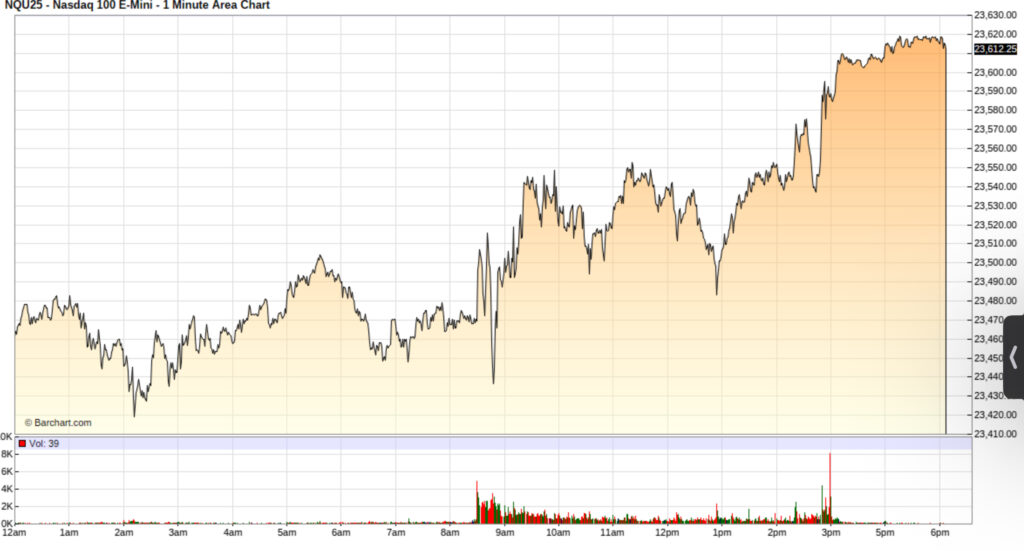Report Date: 2025-08-26
Prices for 2025-08-26
| METRIC | PRICE (NQU25) |
|---|---|
| Open | 23,505.75 |
| High | 23,520.25 |
| Low | 23,371.50 |
| Close | 23,591.50 |

Explanation of Price Movements
On August 26, 2025, Mini NASDAQ 100 futures (NQU25) experienced notable volatility, initially declining before staging a late-day rally to close higher. Early market weakness was primarily attributed to political turbulence following President Trump’s dismissal of Federal Reserve Governor Lisa Cook, which raised concerns about the Fed’s independence. Investors were also cautiously awaiting Nvidia’s upcoming earnings report and facing pressure from initially higher Treasury yields, which typically weigh on growth stock valuations.
However, the market saw a reversal by the end of the trading day. Positive U.S. economic news, specifically stronger-than-expected core capital goods and consumer confidence reports, provided significant support. Additionally, strength in semiconductor makers and indications of progress in trade talks with China, with Vice Commerce Minister Li Chenggang meeting U.S. trade officials, bolstered market sentiment. Bond yields also declined in the afternoon due to strong demand for a Treasury auction, further contributing to the Nasdaq’s gains and allowing the futures to settle higher.
Future Outlook for Mini NASDAQ 100 Futures
The outlook for Mini NASDAQ 100 futures in 2025 is largely positive, primarily driven by the robust growth of the technology sector, particularly advancements in Artificial Intelligence (AI). Institutional and algorithm-based forecasts generally predict a bullish trend, with some projecting the index to reach 24,000 by Q4 2025, and others even suggesting levels near 30,000 by the end of 2026. This optimism is underpinned by anticipated increases in global IT spending, significant investments in AI, and projected double-digit revenue growth in the semiconductor industry driven by AI chip demand. The “Magnificent Seven” tech stocks are expected to continue leading the market, although their outperformance margin may narrow.
Despite this positive momentum, the market faces several economic crosscurrents and potential headwinds. Persistent inflationary pressures, partly due to tariff-induced cost increases, could lead the Federal Reserve to be hesitant in implementing rapid interest rate cuts, keeping the 10-year Treasury yield near 4.5% for the remainder of 2025. While a cooling labor market might encourage rate cuts, the overall U.S. GDP growth is projected to decelerate to around 1.5% in 2025, indicating a more moderate economic expansion. Political uncertainty regarding the Fed’s independence and ongoing geopolitical tensions also present risks for increased volatility. Overall, the underlying innovative strength of the companies within the Nasdaq 100 is expected to drive continued growth, but investors should prepare for periods of volatility influenced by monetary policy shifts and broader economic factors.
Latest Economic Data (as of 2025-08-26)
| ECONOMIC INDICATOR | VALUE | NOTES |
|---|---|---|
| US 10-Year Note Bond Yield | 4.27% | Eased on August 26, 2025 |
| US 30-Year Bond Yield | 4.92% | Rose on August 26, 2025 |
| US Real GDP Growth Q3 2025 (Est.) | 2.2% | Atlanta Fed GDPNow model estimate |
| US Real GDP Growth 2025 (Forecast) | 1.5% | EY & Morgan Stanley forecasts |
| US Real GDP Growth Q1 2025 | -0.5% (annualized) | Contracted due to import surge |
Influence of Economic Factors on Price Movements
Treasury Bond Rates:
The movement of Treasury bond rates significantly influences Mini NASDAQ 100 futures, particularly due to the tech-heavy nature of the Nasdaq 100. Higher Treasury yields generally weigh on risk assets like tech stocks because they increase the discount rate used to value future earnings, making them less attractive, and also offer a more competitive, “risk-free” return in fixed-income investments. On August 26, initial higher yields contributed to early market weakness. However, a late-day decline in the 10-year T-note yield (falling 2 basis points to 4.25%) due to strong demand for a Treasury auction provided relief and supported the market’s rally, indicating that lower yields can act as a tailwind for equity prices. The broader expectation of the Federal Reserve potentially beginning to cut rates in Q4 2025, which saw the 2-year Treasury yield forecast to decline, could reduce borrowing costs for growth-oriented companies and increase the present value of their future cash flows, generally supporting Nasdaq futures. However, persistent inflation and high government debt could keep long-term yields elevated, potentially moderating rapid tech stock appreciation.
GDP Projections:
Gross Domestic Product (GDP) growth is a key indicator of overall economic health, directly impacting corporate earnings and investor sentiment. Strong GDP growth typically signals a robust economy, which can drive Mini NASDAQ 100 futures prices higher as companies are expected to perform well. Conversely, a deceleration in U.S. real GDP growth, as anticipated by EY and Morgan Stanley (1.5% for 2025), suggests a slowing economy that can temper investor enthusiasm and limit upside potential for the tech-heavy Nasdaq. For instance, the contraction in Q1 2025 (-0.5% annualized) due to an import surge ahead of tariffs illustrated how economic slowdowns can negatively affect market performance. On August 26, positive U.S. economic news, including stronger-than-expected core capital goods and consumer confidence reports, which are precursors to GDP, contributed to the market rally. The Atlanta Fed’s GDPNow Q3 2025 estimate of 2.2% growth, while moderate, fosters a sentiment of continued economic activity, which is generally supportive of equity markets. However, a slowing economy with “fragile sentiment” makes the market susceptible to pullbacks if economic data disappoints.


